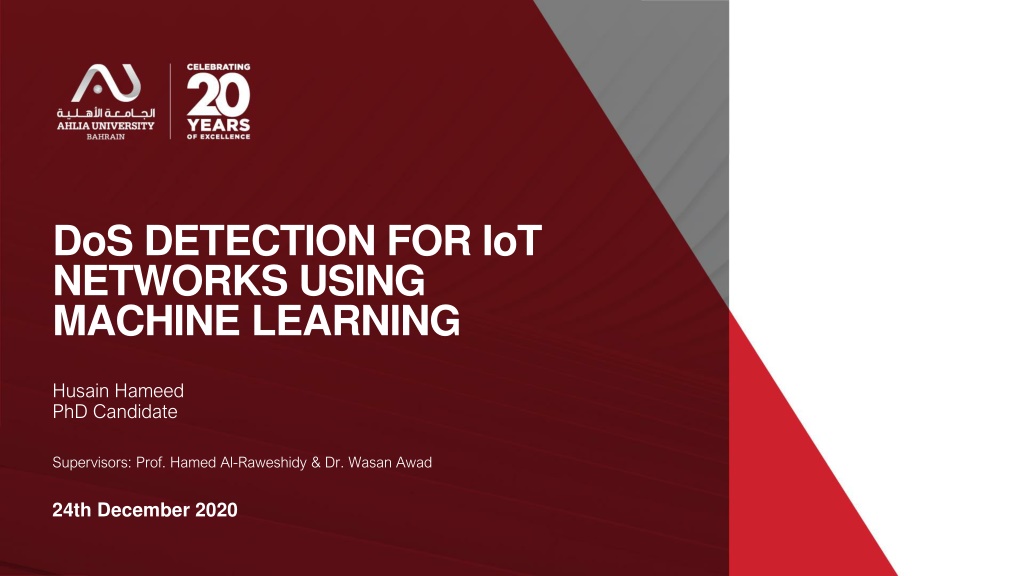DoS Detection for IoT Networks Using Machine Learning: Study Overview
As the number of IoT devices grows rapidly, the need for securing these devices from cyber threats like DoS attacks becomes crucial. This study aims to evaluate the effectiveness of machine learning algorithms such as Gaussian Naive Bayes, K-Nearest Neighbors, Support Vector Machine, and Neural Networks in detecting DoS attacks on IoT networks. The research also focuses on reducing attributes, including precision as a performance metric, and utilizing IoT data samples to enhance detection accuracy. The unique approach integrates different elements into a comprehensive analysis for improving IoT network security.
Download Presentation

Please find below an Image/Link to download the presentation.
The content on the website is provided AS IS for your information and personal use only. It may not be sold, licensed, or shared on other websites without obtaining consent from the author. Download presentation by click this link. If you encounter any issues during the download, it is possible that the publisher has removed the file from their server.
E N D
Presentation Transcript
DoS DETECTION FOR IoT NETWORKS USING MACHINE LEARNING Husain Hameed PhD Candidate Supervisors: Prof. Hamed Al-Raweshidy & Dr. Wasan Awad 24th December 2020
Contents Background & Introduction Objective Related Work & Uniqueness Network Plan & Sample Data Analysis Results Conclusion
Background IoT: refers to physical devices around the world that are connected to the internet. Artificial Intelligence: Ability of machines to perform human-like tasks. Machine Learning: It is a set of algorithms that parse data.
Introduction It is estimated that the number of Internet of Things (IoT) devices will be over 21 billion by 2025 (Camara et al., 2020) There are plenty of these IoT devices that are insecure and prone to attacks (Davis, Mason and Anwar, 2020) DoS is one of the Internet security problems that affects IoT devices.
Objective Test the performance of the following machine learning algorithms in detecting IoT DoS attacks using packet analysis at regular time intervals: Gaussian Naive Bayes K-Nearest Neighbors (KNN) Support Vector Machine (SVM) Neural Networks
Related Work Author Journal Title Observations ANN was excluded from the study, None IoT Data Sample ANN was excluded from the study Security Analysis of Network Anomalies Mitigation Schemes in IoT Networks An Intrusion Detection System for Internet of Medical Things Lawal et al. 2020 IEEE ACCESS Thamilarasu et al. 2020 IEEE ACCESS 2020 International Conference on Artificial Intelligence Anomaly Detection on loT Network Intrusion Using Machine Learning Not all metrics included, None IoT Data Sample Liu et al. 2020 IEEE INTERNET OF THINGS JOURNAL A Supervised Intrusion Detection System for Smart Home IoT DevicesNot all metrics included Anthi et al. 2019
Uniqueness Combine the following elements in a single study: Use IoT Data Sample. Decrease number of attributes to detect DoS. Include Precision as a performance metric. Include ANN.
Network Plan Home gateway router or a middlebox will analyze traffic between consumer IoT devices on the local network (e.g., a smart home LAN) and the rest of the Internet.
Sample Data IoT open source data which contains PCAP traces: A. Sivanathan, H. Habibi Gharakheili, F. Loi, A. Radford, C. Wijenayake, A. Vishwanath and V. Sivaraman, "Classifying IoT Devices in Smart Environments Using Network Traffic Characteristics", IEEE Transactions on Mobile Computing, Aug, 2018.
Data Extraction and Transformation The extracted data was transformed into segments: Attack: The data in benign state were tagged with 0 and during attack with 1. Total length. Length of selected network protocols.
Analysis Results 120% 100% 80% 60% 40% 20% 0% Gaussian Naive Bayes KNN SVM ANN Accuracy Precision in detecting attacks
Conclusion KNN and ANN machine learning models can be used to detect the DoS attacks in IoT networks. ANN performed the best among all the four models achieving an accuracy of %96 with precision of %86 in detecting attacks. This result encourages further research to evaluate DoS detection in real-world IoT networks using ANN.


























